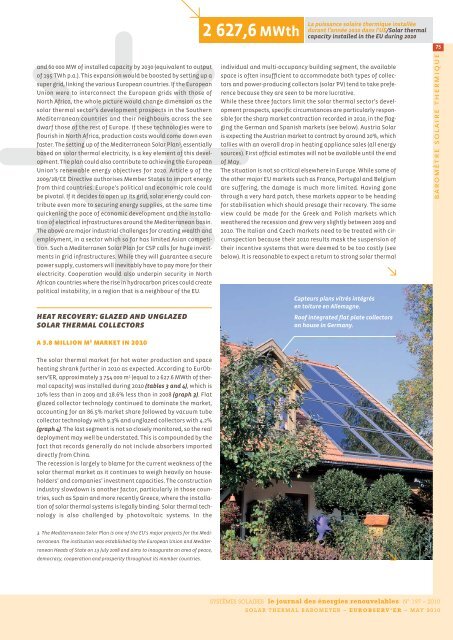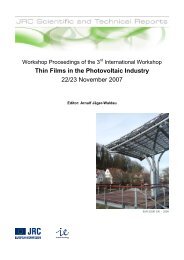BAROMÃTRE SOLAIRE THERMIQUE ET - EurObserv'ER
BAROMÃTRE SOLAIRE THERMIQUE ET - EurObserv'ER
BAROMÃTRE SOLAIRE THERMIQUE ET - EurObserv'ER
You also want an ePaper? Increase the reach of your titles
YUMPU automatically turns print PDFs into web optimized ePapers that Google loves.
75baromètre solaire thermique<br />
2 627,6 MWth<br />
La puissance solaire thermique installée<br />
durant l’année 2010 dans l’UE/Solar thermal<br />
capacity installed in the EU during 2010<br />
and 60 000 MW of installed capacity by 2030 (equivalent to output<br />
of 195 TWh p.a.). This expansion would be boosted by setting up a<br />
super grid, linking the various European countries. If the European<br />
Union were to interconnect the European grids with those of<br />
North Africa, the whole picture would change dimension as the<br />
solar thermal sector’s development prospects in the Southern<br />
Mediterranean countries and their neighbours across the see<br />
dwarf those of the rest of Europe. If these technologies were to<br />
flourish in North Africa, production costs would come down even<br />
faster. The setting up of the Mediterranean Solar Plan 3 , essentially<br />
based on solar thermal electricity, is a key element of this development.<br />
The plan could also contribute to achieving the European<br />
Union’s renewable energy objectives for 2020. Article 9 of the<br />
2009/28/CE Directive authorises Member States to import energy<br />
from third countries. Europe’s political and economic role could<br />
be pivotal. If it decides to open up its grid, solar energy could contribute<br />
even more to securing energy supplies, at the same time<br />
quickening the pace of economic development and the installation<br />
of electrical infrastructures around the Mediterranean basin.<br />
The above are major industrial challenges for creating wealth and<br />
employment, in a sector which so far has limited Asian competition.<br />
Such a Mediterranen Solar Plan for CSP calls for huge investments<br />
in grid infrastructures. While they will guarantee a secure<br />
power supply, customers will inevitably have to pay more for their<br />
electricity. Cooperation would also underpin security in North<br />
African countries where the rise in hydrocarbon prices could create<br />
political instability, in a region that is a neighbour of the EU.<br />
heat recovery: glazed and unglazed<br />
solar thermal collectors<br />
indivi dual and multi-occupancy building segment, the available<br />
space is often insufficient to accommodate both types of collectors<br />
and power-producing collectors (solar PV) tend to take prefe -<br />
rence because they are seen to be more lucrative.<br />
While these three factors limit the solar thermal sector’s development<br />
prospects, specific circumstances are particularly responsible<br />
for the sharp market contraction recorded in 2010, in the flagging<br />
the German and Spanish markets (see below). Austria Solar<br />
is expecting the Austrian market to contract by around 20%, which<br />
tallies with an overall drop in heating appliance sales (all energy<br />
sources). First official estimates will not be available until the end<br />
of May.<br />
The situation is not so critical elsewhere in Europe. While some of<br />
the other major EU markets such as France, Portugal and Belgium<br />
are suffering, the damage is much more limited. Having gone<br />
through a very hard patch, these markets appear to be heading<br />
for stabilisation which should presage their recovery. The same<br />
view could be made for the Greek and Polish markets which<br />
weathered the recession and grew very slightly between 2009 and<br />
2010. The Italian and Czech markets need to be treated with circumspection<br />
because their 2010 results mask the suspension of<br />
their incentive systems that were deemed to be too costly (see<br />
below). It is reasonable to expect a return to strong solar thermal<br />
Capteurs plans vitrés intégrés<br />
en toiture en Allemagne.<br />
Roof integrated flat plate collectors<br />
on house in Germany.<br />
a 3.8 million m 2 market in 2010<br />
The solar thermal market for hot water production and space<br />
heating shrank further in 2010 as expected. According to EurObserv’ER,<br />
approximately 3 754 000 m 2 (equal to 2 627.6 MWth of thermal<br />
capacity) was installed during 2010 (tables 3 and 4), which is<br />
10% less than in 2009 and 18.6% less than in 2008 (graph 3). Flat<br />
glazed collector technology continued to dominate the market,<br />
accounting for an 86.5% market share followed by vacuum tube<br />
collector technology with 9.3% and unglazed collectors with 4.2%<br />
(graph 4). The last segment is not so closely monitored, so the real<br />
deployment may well be understated. This is compounded by the<br />
fact that records generally do not include absorbers imported<br />
directly from China.<br />
The recession is largely to blame for the current weakness of the<br />
solar thermal market as it continues to weigh heavily on householders’<br />
and companies’ investment capacities. The construction<br />
industry slowdown is another factor, particularly in those countries,<br />
such as Spain and more recently Greece, where the installation<br />
of solar thermal systems is legally binding. Solar thermal technology<br />
is also challenged by photovoltaic systems. In the<br />
3. The Mediterranean Solar Plan is one of the EU’s major projects for the Mediterranean.<br />
The institution was established by the European Union and Mediterranean<br />
Heads of State on 13 July 2008 and aims to inaugurate an area of peace,<br />
democracy, cooperation and prosperity throughout its member countries.<br />
Velux<br />
SYSTÈMES <strong>SOLAIRE</strong>S le journal des énergies renouvelables N° 197 – 2010<br />
SOLAR THERMAL BAROM<strong>ET</strong>ER – EUROBSERV’ER – MAY 2010















